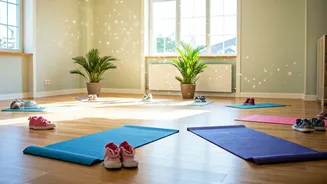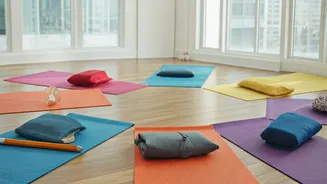Introduction: Yoga's Benefits
Yoga, a practice rooted in ancient traditions, offers a plethora of benefits for both the body and mind. It's particularly beneficial for children, aiding
in the development of essential cognitive skills. Yoga can enhance memory, concentration, and overall mental clarity, helping children excel in their studies and everyday activities. Moreover, the physical postures and breathing exercises foster a sense of calm and well-being. By incorporating yoga into a child's routine, parents can provide a holistic approach to their mental and physical development. The beauty of these exercises lies in their simplicity and accessibility, making them ideal for kids of all ages and abilities. The integration of yoga into daily routines can pave the path for a healthier and more focused future for children.
Tree Pose (Vrksasana)
The Tree Pose, known as Vrksasana, is a balancing posture that remarkably enhances focus and stability. To perform this pose, a child should stand tall, placing one foot on the inner thigh of the standing leg, maintaining a straight back, and keeping the hands in a prayer position at the chest or raised overhead. This asana cultivates a sense of calm and encourages children to concentrate on maintaining their balance. The longer they hold the pose, the more their focus strengthens. By balancing, the pose improves the body's spatial awareness, which can positively impact cognitive functions. The Tree Pose is a perfect example of how yoga combines physical movement with mental discipline, fostering a connection between the body and mind.
Warrior Pose (Virabhadrasana)
The Warrior Pose, or Virabhadrasana, is an energizing pose designed to build both strength and determination while simultaneously improving focus. This pose can be done in several variations (I, II, and III), with each offering unique benefits. To start, a child steps one foot forward and bends the front knee at a 90-degree angle, with the back leg straight, while keeping the torso upright, extending arms, or raising them overhead. Holding this pose for several breaths encourages mental endurance and stability, mimicking the spirit of a warrior. Regular practice of the Warrior Pose boosts confidence and cultivates a sense of self-assurance, which is incredibly beneficial for children. These poses foster a sense of empowerment, helping kids to meet challenges with greater resilience and mental fortitude.
Triangle Pose (Trikonasana)
The Triangle Pose, or Trikonasana, stretches the body while enhancing balance and concentration. To perform this pose, a child stands with their feet wide apart, one foot turned out, and bends to one side, reaching their hand towards the foot while the other hand reaches towards the sky. The gaze should be directed towards the raised hand. This pose demands mindful alignment and control, which strengthens concentration. This improves spatial awareness and promotes mental clarity. Furthermore, the physical stretch invigorates the body, giving children more energy. The Triangle Pose is a great choice for improving the connection between mind and body, promoting a healthy balance between physical activity and mental acuity.
Child's Pose (Balasana)
Child's Pose, or Balasana, is a resting pose that fosters relaxation and reduces stress, ultimately benefiting concentration and memory. To perform this pose, the child kneels down, bringing their forehead to the floor and allowing the arms to rest at their sides or extended overhead. In this posture, children can take deep breaths, allowing their bodies to release tension. This can create a calming effect, improving focus. It can be a great way to take a break during study time or after doing other yoga asanas. The Child's Pose helps to calm the nervous system, preparing the mind for improved cognitive performance, making it a very useful pose.
Downward-Facing Dog (Adho Mukha Svanasana)
Downward-Facing Dog, or Adho Mukha Svanasana, is an invigorating pose that improves blood flow to the brain, which enhances mental clarity and memory. To perform this, the child starts on their hands and knees, then lifts the hips up and back, forming an inverted 'V' shape. This position can boost blood flow and provides a gentle inversion, stimulating the brain and promoting focus. It stretches the entire body, releasing tension. It encourages a calm, clear mind. Regular practice helps children improve their ability to focus and improves their memory.
Cobra Pose (Bhujangasana)
The Cobra Pose, known as Bhujangasana, invigorates the mind and body while improving focus. The child lies on their stomach, places their hands under their shoulders, and gently lifts their chest off the floor, keeping the lower body grounded. This backbend strengthens the spine and opens the chest, enhancing blood flow to the brain, thus promoting mental clarity. It's a great pose for improving focus and reducing fatigue. Doing this exercise regularly leads to increased energy levels and alertness. This pose also helps boost the child's confidence, which is beneficial for a child's overall well-being and academic performance.
Boat Pose (Paripurna Navasana)
Boat Pose, or Paripurna Navasana, strengthens the core and improves balance while enhancing focus and mental clarity. The child sits on the floor, bends their knees, and lifts their legs off the ground while balancing on their sit bones, keeping the torso upright, with arms stretched forward. This pose requires concentration and stability, which strengthen the child's ability to focus. As the core muscles work, the mind must stay engaged and centered. This pose is a good way to build mental resilience, fostering a sharper, more focused mind. The Boat Pose requires children to concentrate and balance, which helps them enhance their memory and attention.
Butterfly Pose (Baddha Konasana)
Butterfly Pose, known as Baddha Konasana, is a gentle pose that helps relax the mind and improve focus. The child sits with the soles of their feet together, knees bent out to the sides, and holds their feet. This pose gently stretches the inner thighs and hips, which can release tension and promote relaxation. The controlled movements and deep breathing associated with the butterfly pose help calm the nervous system, which improves concentration. It is easy to perform and is especially useful for creating a calming effect that supports better focus and memory retention. The butterfly pose helps kids connect their bodies and minds, making them feel better.
Conclusion: Start Today!
Integrating these ten yoga poses into a child's routine can provide substantial benefits for their cognitive abilities and overall wellness. These asanas are easily adapted to different age groups and skill levels, ensuring that all children can participate and enjoy the benefits. Regular practice improves memory power, concentration, and emotional well-being, while fostering a healthy and balanced lifestyle. The integration of yoga into a child's daily routine is a proactive step towards building a brighter, more focused future. Encourage children to explore these poses and discover the many benefits that yoga has to offer for their health and mind.












